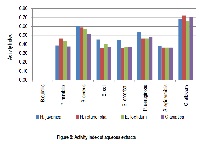Phytochemical screening and antimicrobial activity of four members of family Apiaceae
Keywords:
Apiaceae, Extractive value, Phytochemical screening, Antimicrobial activity, Activity IndexAbstract
The aqueous extract of the four members- Hydrocotyle javanica Thunb., Hydrocotyle rotundifolia Roxb., Eryngium foetidum L. and Centella asiatica L.; of the family Apiaceae were screened for the phytochemicals and for antimicrobial activity against standard microbial strains by in vitro antimicrobial assay using agar well diffusion method. Phenolics, flavonoids and tannins were tested positive in all the four plant extracts. H. javanica emerged to be an effective inhibitor of five of the eight tested microbial strains. B. subtilis exhibited resistance to all the four plants. H. rotundifolia inhibited two strains which were less susceptible to the other plants. The study showed that these traditionally used herbs can be a useful source of antimicrobial agents and their use in the traditional system is scientifically justified.
References
Paulsen BS. Highlights through the history of plant medicine. In: Bioactive compounds in plants – benefits and risks for man and animals. The Norwegian Academy of Science and Letters, 2010, p. 18-29.
Boris O, Gulluce M, Sahin F, Kilic H and Ozkan H. Biological activities of the essential oils and methanol extract of Achillea biebersteinii Afran. (Asteraceae). Turk.J.Biol. 2006. 30: 65-73.
Okoh AL, Ncube NS and Afolayan A. Assessment techniques of antimicrobial properties of natural compounds of plant origin. African J. Biotech. 2008. 7(12): 1797-1808
Gottlieb OR, Borin MR and Brito NR. Integration of ethnobotany and phytochemistry: dream or reality?. Phytochemistry. 2002. 60: 145-152.
Quality control methods for medicinal plant materials. In: World Health Organization, 1998.
Harborne JB. Phytochemical methods: a guide to medern techniques of plant analysis. 3rd ed. New York. Springer Publishing. 1998.
Kokate CK. Practical Pharmacognosy. Delhi. Vallabh Prakashan. 1999.
Trease GE and Evans WC. Pharmacognosy. 15th ed. Saunders. 2002. p 214-393.
Norrel SA and Messley KE. Microbiology Laboratory Manual: Principles and Applications. New Jersey. Prentice Hall. 1997.
Mbata TI, Debiao LU and Saikia A. Antibacterial activity of the crude extract of Chinese green tea (Camellia sinensis) on Listeria monocytogenes. African Journal of Biotechnology. 2008. 7(10): 1571-1573.
Egharevba HO, Iliya I, Nneka I, Abdullahi MS, Okwute SK and Okogun JI. Broad Spectrum Antimicrobial Activity of Psidium guajava Linn. Leaf. Nature and Science. 2010. 8(12): 43-50.
Cowan MM. Plant Products as Antimicrobial Agents. Clin. Microbiol.Rev. 1999. 12(4): 564–582.
Valsaraj R, Pushpangadan P and Smitt UW. Antimicrobial screening of selected medicinal plants from India. J Ethnopharmacol.1997. 58: 75-83.
Haslam E. Natural polyphenols (vegetable tannins) as drugs: possible modes of action. J. Nat. Prod. 1996. 59: 205–215.
Wang P, Su Z, Yuan W, Deng G and Li S. Phytochemical Constituents and Pharmacological Activities of Eryngium. Pharmaceutical Crops. 2012. 3: 99-120.
Kartal M, Mitaine-Offer AC, Abu-Asaker M, Miyamoto T, Calis I, Wagner H and Lacaille-dubo MA. Two new triterpene saponins from Eryngium campestre. Chem. Pharm. Bull. 2005. 53(10): 1318-1320.
Ndip RN, Malange Tarkang AE, Mbullah SM, Luma HN, Agnes M, Ndip L M, Kennedy N, Clare W and Efange SN. In vitro anti-heliobacter pylori activity of extracts of selected medicinal plants from North West Cameroon. J. Ethnopharmacol. 2007. 114(3): 452-457.
Valsaraj R, Pushpangadan P and Smitt UW. New anti- HIV-1, antimalarial and antifungal compounds from Terminalia belerica. J Nat Prod. 1997. 60: 739-742.
Bernhoft A. A brief review on bioactive compounds in plants. In: Bioactive compounds in plants – benefits and risks for man and animals. The Norwegian Academy of Science and Letters. 2008. p. 11-17.
Chandel HS and Tailang, M. Standardization of some herbal antidiabetic drugs in polyherbal formulation. Pharmacognosy Res. 2011. 3(1): 49–56.



